Grey seal
| Grey seal | |
|---|---|

| |
| Male | |
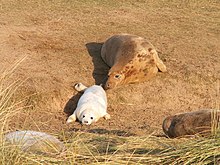
| |
| Female with pup | |
| Scientific classification | |
| Domain: | Eukaryota |
| Kingdom: | Animalia |
| Phylum: | Chordata |
| Class: | Mammalia |
| Order: | Carnivora |
| Clade: | Pinnipedia |
| Family: | Phocidae |
| Genus: | Halichoerus Nilsson, 1820 |
| Species: | H. grypus
|
| Binomial name | |
| Halichoerus grypus (O. Fabricius, 1791)
| |
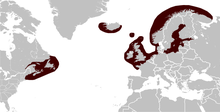
| |
| Grey seal range[1] | |
The grey seal (Halichoerus grypus) is a large
Taxonomy
There are two recognized subspecies of this seal:[4]
| Image | Subspecies | Distribution |
|---|---|---|
 |
Halichoerus grypus grypus Fabricius, 1791 | Baltic Sea |
 |
Halichoerus grypus atlantica Nehring, 1886 | western North Atlantic stock (eastern Canada and the northeastern United States), the eastern North Atlantic stock (British Isles, Iceland, Norway, Denmark, the Faroe Islands, and Russia)[5] |
The type specimen of H. g. grypus (Zoological Museum of Copenhagen specimen ZMUC M11-1525, caught in 1788 off the island of Amager, Danish part of the Baltic Sea) was believed lost for many years but was rediscovered in 2016, and a DNA test showed it belonged to a Baltic Sea specimen rather than from Greenland, as had previously been assumed (because it was first described in Otto Fabricius' book on the animals in Greenland: Fauna Groenlandica). The name H. g. grypus was therefore transferred to the Baltic subspecies (replacing H. g. macrorhynchus), and the name H. g. atlantica resurrected for the Atlantic subspecies.[6]
Molecular studies have indicated that the eastern and western Atlantic populations have been genetically distinct for at least one million years, and could potentially be considered separate subspecies.[7]
Description

This is a fairly large seal, with bulls in the eastern Atlantic populations reaching 1.95–2.3 m (6 ft 5 in – 7 ft 7 in) long and weighing 170–310 kg (370–680 lb); the cows are much smaller, typically 1.6–1.95 m (5 ft 3 in – 6 ft 5 in) long and 100–190 kg (220–420 lb) in weight.[8] Individuals from the western Atlantic are often much larger, with males averaging up to 2.7 m (8 ft 10 in) and reaching a weight of as much as 400 kg (880 lb) and females averaging up to 2.05 m (6 ft 9 in) and sometimes weighing up to 250 kg (550 lb). Record-sized bull grey seals can reach about 3.3 m (10 ft 10 in) in length.[9][10] A common average weight in Great Britain was found to be about 233 kg (514 lb) for males and 154.6 kg (341 lb) for females whereas in Nova Scotia, Canada, adult males averaged 294.6 kg (649 lb) and adult females averaged 224.5 kg (495 lb).[8][11][12] It is distinguished from the smaller harbor seal by its straight head profile, nostrils set well apart, and fewer spots on its body.[13][14] Wintering hooded seals can be confused with grey seals as they are about the same size and somewhat share a large-nosed look but the hooded has a paler base colour and usually evidences a stronger spotting.[15] Grey seals lack external ear flaps and characteristically have large snouts.[16] Bull greys have larger noses and a less curved profile than harbor seal bulls. Males are generally darker than females, with lighter patches and often scarring around the neck. Females are silver grey to brown with dark patches.
Ecology and distribution
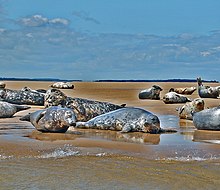


In the United Kingdom and Ireland, the grey seal breeds in several colonies on and around the coasts. Notably large colonies are at Blakeney Point in Norfolk, Donna Nook in Lincolnshire, the Farne Islands off the Northumberland Coast (about 6,000 animals), Orkney and North Rona.[17] off the north coast of Scotland, Lambay Island off the coast of Dublin in the Irish Sea, the Isle of Man, Ramsey Island (off the coast of Pembrokeshire, Wales). In the German Bight, colonies exist off the islands Sylt, Amrum and on Heligoland.[18]
In the western North Atlantic, the grey seal is typically found in large numbers in the coastal waters of the
An isolated population exists in the Baltic Sea,[1] forming the H. grypus balticus subspecies.
Besides these very large colonies, many much smaller ones exist, some of which are well-known tourist attractions, despite their small size. Such colonies include one on the Carrack rocks, Cornwall.
During the winter months, grey seals can be seen hauled out on rocks, islands, and shoals not far from shore, occasionally coming ashore to rest. In the spring, recently-weaned pups and yearlings occasionally strand on beaches after becoming separated from their group.
Grey seals are vulnerable to typical predators for a pinniped mammal; their primary predator would be the
Diet
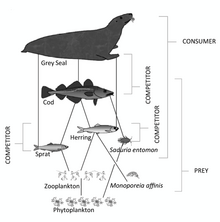
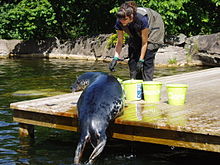
The grey seal feeds on a wide variety of
Recent observations and studies from Scotland, The Netherlands, and Germany show that grey seals will also prey and feed on large animals like
Communication
While it was originally understood that marine mammals communicate vocally, new research conducted by researchers at Monash University shows that grey seals clap their flippers as another form of communication. They clap their flippers underwater to deter a predator from attacking. If done during the mating season, the clapping can be used as a way to find a potential mate. The Monash researchers point out that seals are typically known for clapping, so this behavior may not be a surprise, but the clapping we know typically occurs in captivity. Clapping seals are associated with aquariums and zoos, but were never observed in the wild for this behavior. They were astonished at how loud these marine mammals were able to clap underwater, but it is logical for the reasons they do this.[34]
Reproduction

Grey seals are capital breeders; they forage to build up stored blubber, which is utilised when they are breeding and weaning their pups, as they do not forage for food at this time. They give birth to a single pup every year, with females' reproductive years beginning as early as 4 years old and extending up to 30 years of age. All parental care is provided by the female. During breeding, males do not provide parental care but they defend females against other males for mating.[35] The pups are born at around the mass of 14 kg.[36] They are born in autumn (September to December) in the eastern Atlantic and in winter (January to February) in the west, with a dense, soft silky white fur; at first small, they rapidly fatten up on their mothers' extremely fat-rich milk. The milk can consist of up to 60% fat.[36] Grey seal pups are precocial, with mothers returning to the sea to forage once pups are weaned. Pups also undergo a post-weaning fast before leaving the land and learning to swim.[37] Within a month or so they shed the pup fur, grow dense waterproof adult fur, and leave for the sea to learn to fish for themselves. In recent years, the number of grey seals has been on the rise in the west and the U.S.[38] and Canada[39] there have been calls for a seal cull.
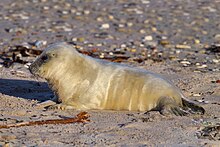
Seal pup first-year survival rates are estimated to vary from 80–85%[40][41] to below 50%[42] depending on location and conditions. Starvation, due to difficulties in learning to feed, appears to be the main cause of pup death.[42]
Status
After near extirpation from hunting grey seals for oil, meat, and skins in the United States, sightings began to increase in the late 1980s. Bounties were paid on all kinds of seals up until 1945 in
Human noise pollution continues to affect marine-life communication but remains an understudied facet of marine conservation efforts. In more recent years, the potential negative effect of human noise has been highlighted with the discovery of seals using clapping as a form of communication.[34]
In the UK seals are protected under the Conservation of Seals Act 1970; however, it does not apply to Northern Ireland. In the UK there have also been calls for a cull from some fishermen claiming that stocks have declined due to the seals.
The population in the Baltic Sea has increased about 8% per year between 1990 and the mid-2000s, with the numbers becoming stagnant since 2005. As of 2011 hunting grey seals is legal in Sweden and Finland, with 50% of the quota being used. Other anthropogenic causes of death include drowning in fishing gear.[47]
Captivity
Grey seals have proved amenable to life in captivity[citation needed] and are commonly found in zoo animals around their native range, particularly in Europe. Traditionally they were popular circus animals and often used in performances such as balancing and display acts.
References
- ^ . Retrieved 19 November 2021.
- ^ a b Sokolov, Vladimir (1984). Пятиязычный словарь названий животных. Млекопитающие. Moscow.
{{cite book}}: CS1 maint: location missing publisher (link) - ^ ISBN 0871130130.
- OCLC 62265494.
- ^ "Gray Seal". NOAA. 8 July 2019. Retrieved 5 January 2021.
- .
- doi:10.1139/z96-199.
- ^ ISBN 9251005141.
- ^ Naughton, D. (2014). The Natural History of Canadian Mammals: Opossums and Carnivores. University of Toronto Press.
- ISBN 0709932685.
- hdl:10088/343.
- .
- ^ "How to identify British seals". BBC Wildlife. BBC. Retrieved 23 October 2015.
- RSPB. Retrieved 23 October 2015.
- ISBN 9780080919935.
- ISBN 978-0-13-317063-4.
- .
- ^ Hahn, Melanie (13 January 2010). "Kegelrobben-Geburtenrekord auf Helgoland". Nordseewolf Magazin (in German). Archived from the original on 31 March 2016. Retrieved 20 November 2011.
- JSTOR 137818.
- doi:10.1139/f83-040.
- doi:10.15273/pnsis.v45i2.3987 (inactive 31 January 2024).)
{{cite journal}}: CS1 maint: DOI inactive as of January 2024 (link - ^ Weir, C. R. (2002). "Killer whales (Orcinus orca) in UK waters". British Wildlife. 14 (2): 106–108.
- ^ Bloc, D.; Lockyer, C. (1988). "Killer whales (Orcinus area) in Faroese waters". Rit Fiskideildar.
- PMID 31168701.
- ^ Stenman, Olavi (2007). "How does hunting grey seals (Halichoerus grypus) on Bothnian Bay spring ice influence the structure of seal and fish stocks?" (PDF). International Council for the Exploration of the Sea. Retrieved 23 January 2017.
Analysis of fish otolithes and other hard particles in the alimentary tract showed clearly that the herring (Clupea harengus) was the most important item of prey.
- S2CID 55465507. Retrieved 24 January 2017.
- ISBN 978-1-60456-183-8.
- BBC Wales. 25 February 2011. Retrieved 20 November 2011.
- ^ "The Grey Seal". Ask about Ireland. Retrieved 20 November 2011.
- PMID 25429021.
- .
- ^ Hillmer, Angelika (16 February 2015). "Kegelrobben mit großem Appetit auf Schweinswale" [Grey seals with a great appetite for porpoises]. Hamburger Abendblatt (in German).
- ^ Gabbatiss, Josh (15 February 2016). "First video footage of seal drowning and eating a pup". New Scientist.
- ^ a b "Grey seals discovered clapping underwater to communicate". ScienceDaily. Retrieved 19 March 2021.
- S2CID 46975859.
- ^ a b "Autumn spectacle: grey seal colonies". BBC Earth. 10 October 2014. Retrieved 3 January 2015.
- PMID 25897381.
- ^ Bidggod, Jess (16 August 2013). "Thriving in Cape Cod's Waters, Gray Seals Draw Fans and Foes". The New York Times.
- ^ "Plan to cull 70,000 grey seals gets Senate panel's approval". CBC News. Newfoundland & Labrador. 23 October 2012.
- .
- .
- ^ a b "Homepage". Friends of Horsey Seals. Retrieved 19 March 2021.
- ^ S2CID 85652019.
- ^ doi:10.1139/z11-012.
- Boston Globe.
- ^ Gray Seal (Halichoerus grypus grypus): Western North Atlantic Stock (PDF) (Report). NMFS, NOAA. April 2014. pp. 342–350. Retrieved 15 June 2015.
- ^ Bäcklin, Britt-Marie; Moraeus, Charlotta; Kunnasranta, Mervi; Isomursu, Marja (2 September 2011). "Health Assessment in the Baltic grey seal (Halichoerus grypus)". HELCOM Indicator Fact Sheets 2011. HELCOM. Archived from the original on 3 November 2011.





